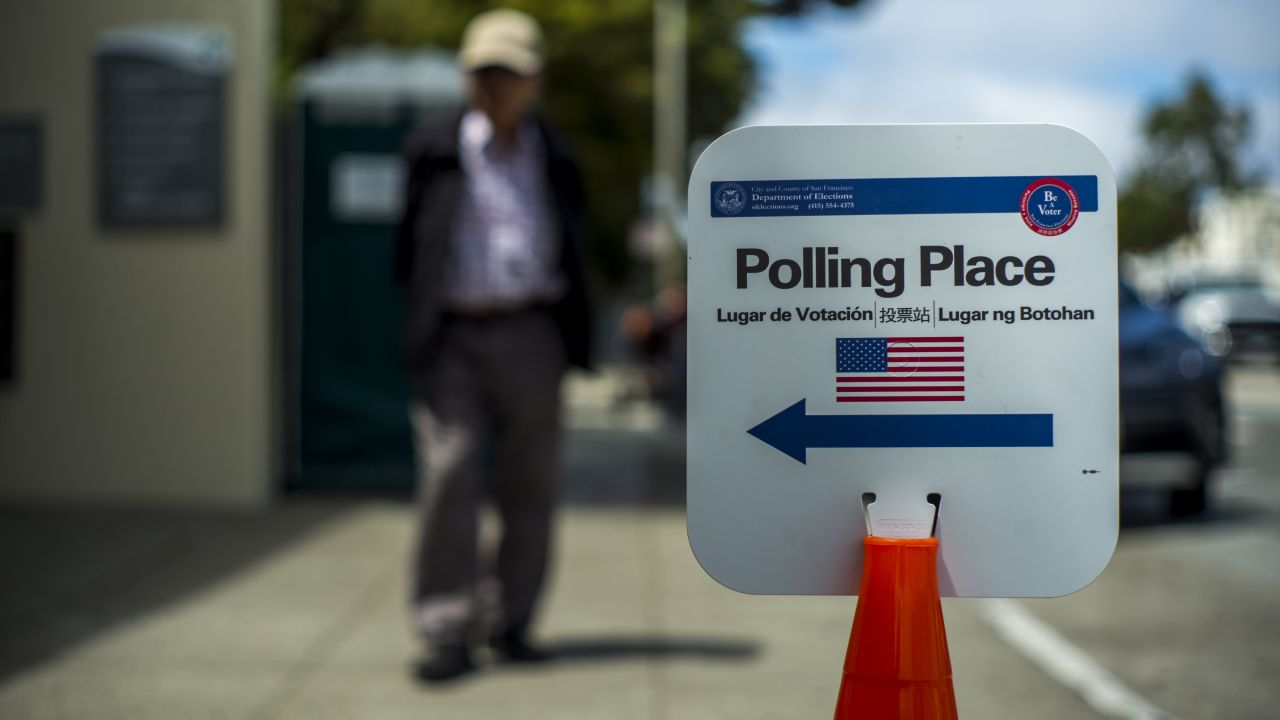
A pedestrian walks towards a "Polling Place" sign during the presidential primary election in San Francisco, California, US, on Tuesday, June 7, 2016. (David Paul Morris/Bloomberg via Getty Images)
This post originally appeared at Common Dreams.
On November 8th citizens in 35 states vote on 163 ballot initiatives. They cover a wide range of subjects (e.g. marijuana, minimum wage, taxes, gun control). To my mind, initiatives in three states — California on reducing drug prices, South Dakota on revamping its political system and New Mexico on the inequitable use of bail — stand out as having a potentially broad national impact.
California Takes on Big Pharma
Californians will vote on a ballot initiative that requires state agencies to pay no more for any prescription drug than the lowest price paid by the US Department of Veterans Affairs (VA) for the same drug. It would apply to more than 1 million state and public university employees as well as 3 million Medicaid patients (although it would exclude 10 million Californians on managed care Medicaid plans.)
Pharma Exec magazine warns its readers, passage of Proposition 61, “would shake the rafters of every single state drug program in the nation, as well as the federal Medicaid and Medicare programs.” It’s a warning well worth heeding. Federal law entitles all state Medicaid programs to the lowest prescription drug prices available to most public and private payers in the US, excluding the VA. Medicaid discounts ordinarily are in the 20 percent range, but VA discounts can be as high as 42 percent. Thus the California measure could extend the VA’s low drug prices to Medicaid programs serving tens of millions of additional people nationwide.
As of October 20, pharmaceutical companies had spent more than $109 million to defeat the measure compared to just $15 million for supporters. Nevertheless, the initiative appears headed to victory.
The pricing of drugs has become a national disgrace. Horror stories abound. Turing Pharmaceuticals purchased the rights to a generic AIDS drug and promptly raises its price from $13.50 to $750 a pill. According to Forbes, prices increased by 100 percent or more between 2013 and 2014 in 222 generic drug groups. Specialty drugs have become astronomically expensive. Reuters reports that in 2014, annual medication costs of 139,000 Americans exceeded $100,000, nearly triple the number who reached that level a year earlier.
The pharmaceutical industry is astonishingly profitable. Median return on assets is more than double the rest of the Fortune 500, according to Alfred Engelberg. The industry is awash in cash. Pfizer holds $74 billion in unrepatriated profits overseas and Merck holds $60 billion, enough to fund their respective annual research budgets for 10 years.
While the industry reaps the financial benefits, the taxpayer bears much of the financial cost. Some observers calculate that direct and indirect government support is such that private industry pays only about a third of R&D costs. Pouring salt in the taxpayers’ wounds, the government gifts these largely publicly funded drugs long-term patent protection. Which is one reason, as the Washington Post reports, drug companies focus on marketing, often spending $2 for marketing for every $1 spent on research.
Despite repeated scandals, the federal government has been unwilling or uninterested in stepping in. Congress hoots and hollers about the outrageous price hikes but specifically prohibits Medicare from negotiating with drug companies for price discounts. Federal law allows the government to unilaterally lower the price of drugs developed with government funds when a company is gouging customers, but the administration so far has refused to wield this power. The government could also allow the import of less expensive equivalent drugs, but the administration has refused to exercise this authority either.
Which leaves it up to the people to assert their own authority, in those states where this is possible. That’s what Californians have done.
South Dakotans take on the political establishment
South Dakotans will vote on three initiatives that, if taken together, could change the face of state politics.
Amendment V converts all state elections into nonpartisan contests. There would no longer be Democrat or Republican primaries. The top two finishers in the first round of voting would face off in the general election. California, Louisiana and Washington have similar run-off systems but in those states candidates still run with a party label. That would be prohibited in South Dakota, making it the only state apart from Nebraska to have purely non-partisan elections. (Nebraska had its own political revolution in 1934 when its citizens rose up against an inefficient and unresponsive political system and voted not only to convert to nonpartisan elections but to introduce the nation’s first and only unicameral state legislature.)
Amendment T creates a commission to redraw state legislative districts every ten years when a new census comes out. Ordinarily redistricting is done by legislators themselves, but as Matt Sibley, one of the organizers for Amendment T, told Governing Magazine, “There is an inherent flaw in the system when legislators are picking out there own legislative districts.” In-house redistricting often results in a number of uncontested legislative races, diminishing the value of the franchise for those living in that district. The new commission will be barred from considering the party affiliation of voters and location of incumbent lawmakers when drawing new maps.
Measure 22 is the most complex of the three initiatives, requiring many changes to election law. The most important is the creation of Democracy Credits. Each registered voter will receive two $50 Democracy Credits they can donate to state legislative candidates who agree to participate in at least three public debates and cap the amount of private money they receive per contributor. Democracy Credits, or Democracy Vouchers as they are sometimes called were first adopted in 2015 by initiative by Seattle voters. (Washingtonians are also voting on the issue. Initiative 1464 gives every registered voter three Democracy Credits of $50 to donate to state legislative candidates who agree to certain conditions.)
New Mexico takes on debtors’ prisons
In November New Mexico may become the first state to directly address a basic inequity of the justice system: the use of bail.
In 1987 the Supreme Court declared, “In our society liberty is the norm, and detention prior to trial or without trial is the carefully limited exception.” Nevertheless, in most of America, lower-income people who have been arrested and can’t afford bail sit in jail for weeks, months, even years before seeing a judge. Their involuntary incarceration can result in lost jobs, lost income and increased family stress all of which raise the likelihood of guilty please and reoffending.
According to the Department of Justice, 95 percent of the growth in the jail population since 2000 is attributed to an increase in pretrial detainees, Christopher Moraff reports in Next City. According to the Vera Institute of Justice, the average number of days that people stay in jail awaiting trial has increased from 14 days in 1983 to 23 days in 2013. Nationwide, according to a Harvard Law School report, 34 percent of defendants are kept in jail pretrial solely because they are unable to pay a cash bond. In 2011 60 percent of local jail inmates were pretrial detainees and 75 percent of those detainees were charged with property, drug or other nonviolent offenses.
The perverse and unjust consequences of bail have begun to receive national attention as part of the larger concern about the revival of issue of the revival of debtors’ prisons. In March, the Justice Department sent a letter to judges cautioning them that employing “bail or bond practices that cause indigent defendants to remain incarcerated solely because they cannot afford to pay for their release” is a violation of the Fourteenth Amendment guarantee of equal protection.
In 2015 Equal Justice Under Law and the Southern Center for Human Rights filed a class action lawsuit against the city of Calhoun, Georgia for its practice of requiring bail for indigent defendants even when that would force them to remain in jail. The case involved a disabled man jailed for six days because he couldn’t afford to pay a $160 fixed cash bail bond. In January the District Court ruled in their favor, issued an injunction against the city of Calhoun, and ordered it to implement a new bail scheme and release any misdemeanor arrestees in the meantime.
The city has appealed, arguing, “the Constitution does not guarantee bail, it only bans excessive bail.”
In August the Department of Justice for the first time submitted a formal amicus brief on the subject of bail to the 11th Circuit Court of Appeals on behalf of the plaintiffs.
Some jurisdictions have begun to change their pretrial release policies so that danger to the community and likelihood of flight are the main factors to determine pretrial release, not whether the accused can pay bail, with significant success. In a New York City pilot program, 1,100 people were granted supervised relief; 87 percent showed up to court when required without incident. From July 2013 to December 2014, Mesa County, Colorado was able to reduce its pretrial jail population by 27 percent without negative consequences for public safety.
Washington, DC has run an essentially cashless justice system for those accused of misdemeanors for many years. Nearly 88 percent of defendants in DC are released with non-financial conditions. Between 2007 and 2012, 90 percent of released defendants made all scheduled court appearances; over 91 percent were not rearrested while in the community before trial. Ninety-nine percent were not rearrested for a violent crime.
The New Mexico initiative originated with a murder case in which the defendant remained in jail for more than two years without going to trial even though he agreed to wear a GPS device, make regular contact with the court and was not considered a danger to the community or likely to flee. The state Supreme Court ruled in favor of the defendant. A task force recommended an amendment to the “right to bail” provision in the New Mexico constitution.
Constitutional Amendment 1 is a legislatively referred initiative passed with broad bipartisan support. No group is campaigning against it. Perhaps because it is a result of legislative action, the initiative reflects the give and take of the legislative process. Thus the Amendment also gives judges more discretion to keep dangerous people in jail — even if they can afford bail. A study from the Laura and John Arnold Foundation shows that nearly half of the highest-risk defendants are released pending trial while low-risk, non-violent defendants are frequently detained.
Perhaps more important, negotiations have resulted in final language more problematic than the original. Originally the Amendment was clearly and directly stated: “A person who is not a danger and is otherwise eligible for bail shall not be detained solely because of financial inability to post a money or property bond.” The final language reads, “A defendant who is neither a danger nor a flight risk and who has a financial inability to post a money or property bond may file a motion with the court requesting relief from the requirement to post bond. The court shall rule on the motion in an expedited manner.”
Some worry the additional conditions might raise barriers to achieving the objective. But most are optimistic that the New Mexico law will break new ground in efforts to make the justice system more equitable. New Mexico Supreme Court Chief Justice Charles W. Daniels, a prime mover behind the initiative contends, “There is nothing I’ve done or will do on the court that is going to be a more important improvement of justice than getting this amendment passed.”
Whatever the outcome of the elections, a tip of the hat is in order to the citizens of California, New Mexico and South Dakota for giving themselves the opportunity to directly address some of the key problems facing the country.




